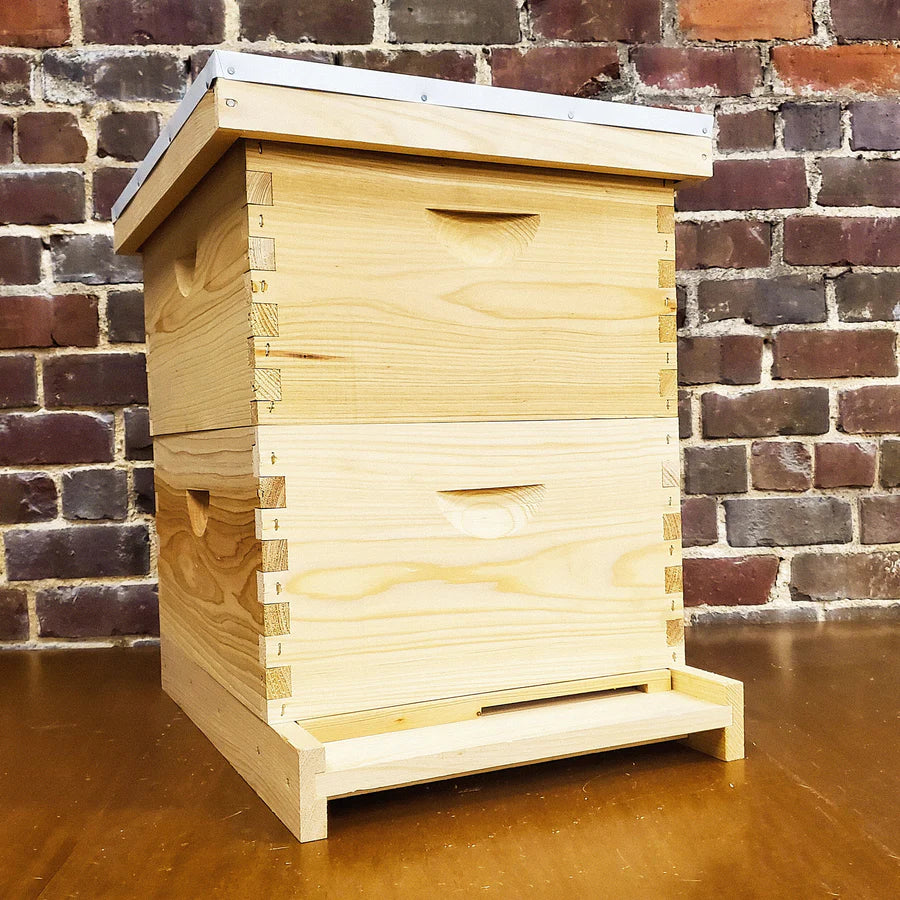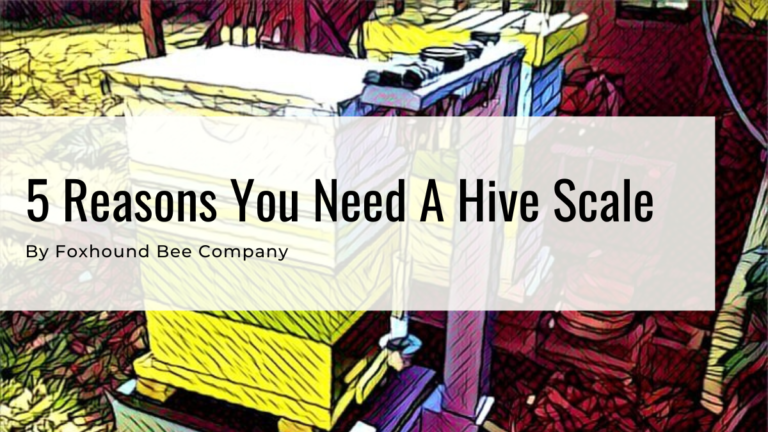

At Foxhound Bee Company, we started using a scale on one of our hives back in 2016. It was one of the large platform scales that worked great for us. It was made by Cardinal Detecto and worked great because it had weights that would slide back and forth to measure changes in hive weight.
We ended up selling that platform scale even though it did a great job recording the weight of the hive. Mainly because it was challenging to record the weight daily, and keeping track of the hive’s weight was a task we couldn’t keep up with. You can read more about that hive scale on our blog, 5 Reasons You Need A Hive Scale.
It is also possible to use other tools like a luggage scale device, but that still requires going out to the beehive to weigh it. And weighing the hive every day or every couple of days is usually tiresome.
See below for our hive scale data and more information about the hive monitoring system we use.
At Foxhound Bee Company, we started using a scale on one of our hives back in 2016. It was one of the large platform scales that worked great for us. It was made by Cardinal Detecto and worked great because it had weights that would slide back and forth to measure changes in hive weight.
We ended up selling that platform scale even though it did a great job recording the weight of the hive. Mainly because it was challenging to record the weight daily, and keeping track of the hive’s weight was a task we couldn’t keep up with. You can read more about that hive scale on our blog, 5 Reasons You Need A Hive Scale.
It is also possible to use other tools like a luggage scale device, but that still requires going out to the beehive to weigh it. And weighing the hive every day or every couple of days is usually tiresome.
See below for our hive scale data and more information about the hive monitoring system we use.
Live Hive Scale Data From Foxhound Bee Company Apiary - 35203
Live Hive Scale Data From Foxhound Bee Company Apiary - 35203

The colony that this Broodminder system is monitoring includes a 10 frame Langstroth hive with 2 cypress deep boxes, 18 deep frames with plastic foundation, a 2-frame internal syrup feeder, solid bottom board, inner cover, and a telescoping cover. This is a full-size colony that has this equipment on it for most of the year except during the honey flow, which is typically between March and June.
For a direct link to the data with interactive settings, click here.
The tools used to monitor this hive include a digital Broodminder hive scale, a temperature and humidity sensor, and a wifi receiver

The colony that this Broodminder system is monitoring includes a 10 frame Langstroth hive with 2 cypress deep boxes, 18 deep frames with plastic foundation, a 2-frame internal syrup feeder, solid bottom board, inner cover, and a telescoping cover. This is a full-size colony that has this equipment on it for most of the year except during the honey flow, which is typically between March and June.
For a direct link to the data with interactive settings, click here.
The tools used to monitor this hive include a digital Broodminder hive scale, a temperature and humidity sensor, and a wifi receiver
Support for this graph provided by BroodMinder,Google,WeatherSource
Support for this graph provided by BroodMinder,Google,WeatherSource
By far, the most valuable information we collected from the hive scale was the weight of the colony. With that information, we could subtract the weight of the wood, wax, and bees to get a general number for how much honey is in the hive.
The hive scale is great for the hobbyist beekeeper because it gives them accurate data that usually takes a couple of years of experience to gather.
For experienced beekeepers, it’s possible to look at the plants blooming, the weather, and even how many bees are in the hive to learn if the bees are making excess honey.
By far, the most valuable information we collected from the hive scale was the weight of the colony. With that information, we could subtract the weight of the wood, wax, and bees to get a general number for how much honey is in the hive.
The hive scale is great for the hobbyist beekeeper because it gives them accurate data that usually takes a couple of years of experience to gather.
For experienced beekeepers, it’s possible to look at the plants blooming, the weather, and even how many bees are in the hive to learn if the bees are making excess honey.
We don’t use the old platform scale anymore, but we use a more advanced technology that works through a mobile phone, wifi, Bluetooth and even over cellular. This is the Broodminder Hive Monitoring System that has been around for many years and keeps improving.
These smart hive scales we use now can determine the weight of the hive every hour, upload the data to the internet automatically, and can provide up-to-date information without ever having to open the hive.
In addition to the hive scale, we use a temperature and humidity sensor that is placed inside the hive that can tell us if the colony is healthy, preparing to swarm, queenless, broodless, and more. We use this system and also sell it as a part of the everyday bee supplies we carry at Foxhound Bee Company.
We provide our data so you can see what the hives we monitor are doing, which can help you in your beekeeping operation as well. All beekeeping is local, but if you have a similar climate to the location of our monitored apiary, you also can expect your hives to be reacting to the environment similarly.
We don’t use the old platform scale anymore, but we use a more advanced technology that works through a mobile phone, wifi, Bluetooth and even over cellular. This is the Broodminder Hive Monitoring System that has been around for many years and keeps improving.
These smart hive scales we use now can determine the weight of the hive every hour, upload the data to the internet automatically, and can provide up-to-date information without ever having to open the hive.
In addition to the hive scale, we use a temperature and humidity sensor that is placed inside the hive that can tell us if the colony is healthy, preparing to swarm, queenless, broodless, and more. We use this system and also sell it as a part of the everyday bee supplies we carry at Foxhound Bee Company.
We provide our data so you can see what the hives we monitor are doing, which can help you in your beekeeping operation as well. All beekeeping is local, but if you have a similar climate to the location of our monitored apiary, you also can expect your hives to be reacting to the environment similarly.
